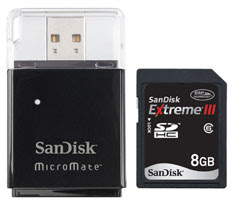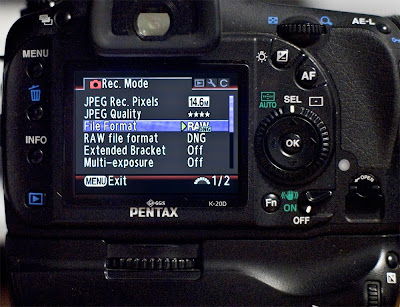This article is not intended to be a highly technical dissertation. It is intended to be a real life shooting approach for better pictures.
Early in 2008, I posted several articles (Link) (Link) about shooting RAW. It seems that many
 photographers had reservations about shooting RAW. The most common reason was that RAW took too much space on the memory cards and that JPG were just fine for what they were shooting. Well, I think it’s time that you shoot RAW if you haven’t already done so. I just purchased an 8GB SDHC card for $49.00. With the K20D @ 14.6MP, that gives me 330 image files and 482 image files with the K200D. Long gone are the 128MB SD cards.
photographers had reservations about shooting RAW. The most common reason was that RAW took too much space on the memory cards and that JPG were just fine for what they were shooting. Well, I think it’s time that you shoot RAW if you haven’t already done so. I just purchased an 8GB SDHC card for $49.00. With the K20D @ 14.6MP, that gives me 330 image files and 482 image files with the K200D. Long gone are the 128MB SD cards.With the Pentax newer generation of DSLRs, you can shoot RAW-PEF (Pentax RAW format) or RAW-DNG (Adobe universal format). Some or most of the photo galleries even upload the DNG files, such as Google’s Picasa.
Therefore, why anyone would keep shooting JPG is beyond me.
RAW files are the “negatives” of the digital world. In the film era, the negatives were vital in making multiple prints or enlargements. With the negatives, through the lens of an enlarger, the development of the images on emulsion paper could be further modified with dodging, burning, as well as color corrections. You would never have thrown away negatives on purpose. The RAW files are the information recorded by the DSLR in it’s purest useable form. The images are recorded at 12-bit per channel color bit-depth. In simple terms, Pentax RAW files contain 4096 levels of information or tones per channel. JPG files are 8-bit and support only 256 levels of information or tones per channel. The more information you have saved, the better the end results will be.

JPG files are in-camera processed and compressed image files. The camera applies pre-determined settings for white balance, contrast, color correction, sharpening and saturation. The files are then compressed to reduce the sizes. The results; completed and processed image files written to the camera’s storage card. You can never go back to the original RAW files taken by the camera.
On the other hand, you can manipulate RAW files on a computer with much more latitude. Desktop computers have much more powerful tools to convert your RAW files to JPG, in a non-destructive way. The RAW files can be saved for future enhancements, if needed. (Actually, highly recommended). Who knows what new software will be coming out in the future?
Here is a neat trick you can use with RAW files. When the lighting is less than perfect, instead of pumping up the ISO, go ahead and under-expose by about 1 to 2 stops. (Instead of say f4 @ 1/60 sec as per the DSLR metering system, use f4 @ 1/250 sec.) Yes, the picture will be a little too dark. Later, using tools like Lightroom or similar software lighten up the image and you will have a tack-sharp image with minimal noise. Try it; you will see that it really works.
Thank you for reading,
Yvon Bourque

4 comments:
I couldn't agree more!
I shoot PEFs on the K10D because they take up less space than DNG (which doesn't get compressed). But when I download to the computer I convert them in ACR to compressed DNG, which take up less space than PEFs :-)
Why would anyone shoot JPG? Compare the FPS of RAW shooting and JPG shooting and see for yourself. 3 fps, 7 shots and the K20d pauses for several seconds while unloading the buffer to the SDHC card. Wit h JPGs you can shoot 25-30 shots @ 3fps and they are written to the card almost instantly.
Well, there is a small difference in size between a 40 MBytes RAW and a 4 MByte JPG, isn't it?
I also shoot RAW 99% of the time. I have a K20 and use DNG. I figure it might be more compatible in the future. However, I am not sure what the difference is between DNG & PEF. Does one have an advantage over the other?
Thanks.
Jeffrey
www.pomranka.net
Ever since i've discovered RAW and the latitude that is offered to us regarding the edit/post-processing capability is nowhere near JPEG.
Storage is cheap these days, and yeah, maybee you will fill up your hard disk pretty quickly, but again, storage is cheap!
Post a Comment